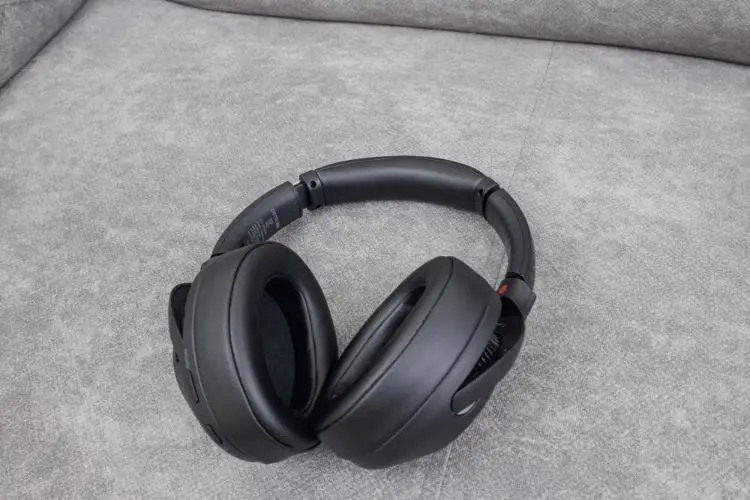As I’ve gotten older, I’ve started to feel the frustration of fighting to understand dialog on TV while keeping the volume at a sane level. Even when the volume seems fine and reasonable, sometimes words drop out and it gets more difficult to follow a story or pick up all of the information being thrown at me. Headphones have been the answer for many of us in this situation. But, what should you take into account when choosing the best TV headphones for seniors and the hard of hearing in 2021?
The best headphones for seniors and the hard of hearing will be comfortable, easy to connect to your home entertainment system, have excellent sound, and be well within your budget. I like Sony’s WH-1000XM4, but there are many other good options depending on your situation.
Before you decide on wireless TV headphones, you should take into consideration all of the factors listed below. You probably won’t find any models on the market today that score a 10 out of 10 in every category; however, you should be able to find something that ticks every box and makes you happy.
I place a lot of importance on comfort and sound quality on my scale. If you can’t wear a pair of headphones for extended periods and truly enjoy the sound they produce, what’s the point?
So, why do you want wireless headphones for your TV?
First, start with why you’re purchasing wireless TV headphones. Take the following reasons for instance:
- Simply to provide better clarity for dialog and music at reasonable volume levels
- To eliminate noise from neighbors or other sources around you
- To hear the TV better while moving around the room
Clarity and volume
Better clarity is kind of a given when it comes to finding the right wireless headphones. But if you pay attention to your habits when you’re watching TV or listening to music, it can tell you a lot about why you need that clarity even beyond just a more enjoyable TV experience.
Volume level is one of the main reasons people shift to using wireless headphones for TV. Even unintentionally, we can frustrate and annoy our family and neighbors by constantly raising the volume level on the TV simply because we can’t understand what’s being said. Over time, it can cause real rifts between friends and family.
Because speakers are made of parts that physically move when they’re playing sound, over time they will break down. This is true of any physical moving part. The louder you play sound through any speaker, the quicker it will break down. Turning the volume up substantially over a prolonged period will affect your TV, stereo, or soundbar speakers.
Clearer dialog and music at lower volumes can alleviate headaches, it can protect your devices from early breakdown and wear, and it can save relationships between spouses, roommates and neighbors.
You may also find yourself needing to read lips a lot less often. You might also be able to eliminate closed captions. When you can hear the dialog better, you can more easily watch the action and the background scene to pick up more of the subtext of the show you’re watching. This can definitely add to the enjoyment of watching TV.
Freedom to roam
Do you like to vacuum while keeping up with your favorite TV show on the Amazon Fire TV Stick? Find yourself running to the fridge for a drink often during your live TV shows? Moving around the room can be very difficult for people who have a hard time hearing the TV in the first place.
With the right set of wireless headphones, you’ll be able to move around the room, and possibly even between rooms if your house is small enough. The recent versions of Bluetooth are strong enough to stay connected over distances well beyond a room or two.
RF headphones work over a network similar to the one created by your home router, or even like a small radio station. Because of this, you can most likely move around most of your house and still listen to your TV or streaming device.
Headphones aren’t just for TV anymore
Yes, that was a joke. But, it’s still true. Wireless headphones can be used to connect to your TV and listen to movies and shows, but they can also be used to stream music from Spotify, or take calls from your cell phone.
If you have a streaming device, you can actually listen to movies, TV shows, and streaming music all from the same place. You just need to make sure you have the proper apps installed, and you’re good to go.
Modern cell phones are easy to pair with Bluetooth headphones and earphones. You will need to make sure that your choice includes a microphone, but this is pretty standard on most Bluetooth headphones these days.
And if you’re using Zoom or FaceTime to stay connected with family and friends, a good set of wireless headphones makes the experience much more comfortable and enjoyable.
How to find the best wireless TV headphones for seniors
Some things to consider are obvious when you’re choosing between wireless headphones. Comfort, for instance, is very important and is probably top of mind when you’re researching or trying on different models.
But, not everyone is aware that there can be a pretty significant difference between on-ear headphones and over-the-ear headphones when it comes to comfort. Let’s take a look at some of the obvious and not-so-obvious factors that go into a good decision when you’re shopping for wireless TV headphones.
Over-the-ear vs on-ear vs in-ear headphones
I’m focusing primarily on headphones in this article, so over-the-ear or on-ear models mostly. However, I do want to point out that there are some great in-ear headphones (or earphones) that you might want to consider. I’ll talk about this more in a second, but remember that in-ear earphone models won’t work if you wear a hearing aid.
If you aren’t sure which type of headphones is most suitable for you, I highly recommend going out and trying some on. It’s difficult to know if you prefer over-the-ear headphones or on-ear models without comparing them in person.
Here’s the difference between them:
Over-the-ear headphones literally fit “over the ear” and encompass your entire ear, or most of it. The cup is usually made of soft foam, and it should be very comfortable feeling right away. If it’s not, it will only get less comfortable the longer you wear them. Over-the-ear headphones are likely to make you feel as though the sound is encompassing you as well, which can be wonderful. It may also be harder to hear the outside world while wearing these types of headphones.
On-ear headphones are, again, just what the name sounds like. They fit “on your ear” and don’t encompass your entire ear while you’re wearing them. They should also be soft and comfortable. The pressure of the fit with these headphones is important. If your ears feel squeezed and you can’t adjust the pressure, this is not a good fit. They will become unbearable over time.
Wearing headphones with glasses
If you wear glasses while you watch TV, you’ll want to make sure that your headphones are really comfortable to wear at the same time as your glasses. This is important because some models can push the frames of your glasses into the side of your head or your ears and actually cause pain over time.
I like over-the-ear headphones with my glasses because I can position the frame of my glasses so they’re almost floating just off my nose, but they aren’t digging into my ears or head. The amount of pressure and overall fit of your headphones will determine how comfortable they are to wear with your glasses. So, make sure to bring your glasses with you when you go test headphones in person.
Just as a note, this is one of the primary reasons that some people opt for in-ear TV headphones. Wearing glasses with earphones can be more comfortable for some people if you don’t mind the earphone in your ear for prolonged periods.
Wearing headphones with hearing aids
Just like with glasses, make sure to consider how your headphones will feel and sound if you wear hearing aids with them. This really depends on your level of need with your hearing aids though. If the headphones themselves make the hearing aids unnecessary, then this isn’t an issue.
However, if you need them all the time, you’ll want to see how they feel with different models of headphones. The fit is really important when it comes to pairing them with hearing aids. Too tight of a fit can cause discomfort over time. Making sure that the cups of the headphones don’t hit the microphone of your hearing aids is crucial.
One other thing that some users report is feedback between the headphones’ speaker and the microphone of the hearing aids. If the two are positioned too close together, you can end up with a feedback loop right in your ear. Listening for several minutes at different volume levels should be enough to tell you if a certain model will work with your hearing aids or not.
Should you get noise canceling headphones?
This is a bigger decision than some people realize. If you haven’t worn noise canceling headphones before, you’ll want to try them out in a store before you purchase them.
For some people, noise canceling headphones can cause discomfort. While the technology that enables noise canceling to work doesn’t appear to have any negative impact on the pressure of the listener’s eardrums, it can still cause the feeling of pain, discomfort, and sometimes even nausea.
I know this to be true actually because I am one of the people that experiences this. Strangely, wearing my glasses at the same time tends to increase the discomfort as well. It seems that most people are just fine with noise canceling headphones, just be aware that this is a possibility. If you’re unsure, test them in person. You’ll know pretty quickly if you experience this kind of discomfort.
I will say, however, that even for me, in moderation, noise canceling headphones can be great. And there are some models of headphones that allow you to adjust the level of noise cancellation. Headphones that feature noise cancellation almost always allow you to turn it on and off.
One other thing to consider is that noise cancellation is not a perfect science. If you’re wanting to eliminate noise from a noisy neighbor, for instance, you may be out of luck with headphones. I know this from experience as well. While they will minimize the noise in a certain range, banging and screaming will, unfortunately, still come through.
Comfort
Now that we’ve discussed some of the possible issues in determining comfort with wireless TV headphones, such as wearing them with glasses or hearing aids, let’s talk about comfort a bit more generally. What makes headphones comfortable anyway?
Weight is a big factor. This is probably one of the most important things to consider when choosing the right headphones for watching TV.
If you’re going to be watching for an hour or more at a time, heavy headphones will get heavier by the minute. Bulky, heavy wireless headphones can also just feel overwhelmingly uncomfortable when paired with glasses. Light headphones make long movies and TV show binge-watching sessions much more enjoyable.
The material that the cups are made from is also a prime consideration for comfortable wireless headphones. If the foam is too stiff, your ears will get sore. But if the cups are made from floppy material, they’re likely to wear out very quickly and fall apart on you. You want to find solid, but soft and comfortable material for either over-the-ear or on-ear headphones.
Overall tightness and adjustability are also key when it comes to the perfect fit. You should be able to adjust the headphones so that they fit the size of your head just right. And if you can’t get a nearly perfect amount of pressure on your ears, I’d recommend that you keep looking. This is another thing that will absolutely compound over time.
Wireless headphone connection types
Wireless headphones provide different options for connecting to your TV, streaming device, or soundbar. We’ll go over two of the most common, RF and Bluetooth.
RF, or radio frequency, is a technology that has been used for many years. As PCMag explains, “RF transmission includes AM and FM radio, analog and digital TV, satellite communications, cordless phones, cellular and Wi-Fi.” It can also be used to broadcast your TV’s audio signal when a transmitter is connected to an audio port. You can then use a pair of RF wireless headphones to connect to the transmitter and enjoy movies, TV shows, and music.
Obviously, you don’t need to know anything about how RF technology works in order to use and enjoy its benefits. But you should know a few facts about its benefits and drawbacks.
RF wireless headphones
RF wireless systems are able to transmit signals over much longer distances than Bluetooth. It’s also able to provide multiple connections, so more than one viewer can use wireless headphones at the same time.
In the negative column, RF headphones work on the more powerful end of the spectrum, which could expose the user to a stronger EMF signal. Just be aware that these devices are widely considered safe. More on that later. Since RF transmitters act like tiny radio stations, others might be able to connect and listen to what you’re watching as well, although this is unlikely.
Something that’s a bit more likely is signal interference. RF transmitters can experience some interference from other devices in or near your home, even including your microwave oven.
Bluetooth wireless headphones
While Bluetooth is actually a form of RF technology, it runs on a different, much lower area of the spectrum. This can mean it’s a bit safer in terms of EMF exposure, but it also means that you won’t get as great of a distance with your connection. However, if you’re using the headphones in the general vicinity of your TV, for the most part, this shouldn’t be a problem.
Bluetooth headphones can also be used with many of your other devices, such as your cell phone. I’ve always used Bluetooth headphones and haven’t had a problem with them at all.
Ease of use
Lastly, let’s talk about ease of use. Some headphones require the use of a mobile app of some kind to get the most out of them. If you’re OK with installing and using mobile apps, this can actually provide a lot of extra functionality. But, if you’re not a big fan of using apps to control devices, you might want to consider another option.
Also, pay attention to the controls on the headphones you’re thinking of buying. Are they easily accessible? Some models have controls that are easily activated accidentally when removing or adjusting the headphones, so make sure to read reviews and see what other users are saying.
Lastly, consider how easily you can connect them to your TV, streaming device, or soundbar. This goes beyond simply plugging them into your TV set. For instance, read up on how easily they pair with your devices. And if you’re using the headphones for multiple devices, make sure you can easily go between them without too much trouble.
Are RF and Bluetooth technologies safe?
Previously, I mentioned EMF (electromagnetic fields) signals in regard to safety. Most of the electronic devices in our lives create some EMFs, and it’s been debated whether or not there’s any danger with them. In general, studies show that RF technology, which can produce those EMFs, is safe for the public at low levels.
A study from the NIH found the following:
Despite unavoidable uncertainty, current scientific data are consistent with the conclusion that public exposures to permissible RF levels from mobile telephony and base stations are not likely to adversely affect human health.
As a consumer, it’s always up to you to make your own decisions about what’s safe and healthy, but as that study also mentions, we’ve been using RF technology widely for over 50 years without noticeable effects.
Best wireless TV headphones for seniors or hard of hearing – wrap-up
A great pair of wireless TV headphones for seniors or the hard of hearing should be great for TV and movie dialog, excellent for music quality, and they should feature clarity throughout the entire sound spectrum, including bass.
They should be incredibly comfortable for prolonged periods of time, with or without both glasses or hearing aids.
They should be easy to connect and use, and they should not break your budget.
Whether you intend on buying headphones online or in person, it’s important to try some on so you know which types you like best and whether certain features, like noise cancellation, are right for you.
If you have any questions or you have any favorites or suggestions, let us know in the comments.






